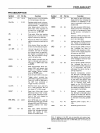
8291
handling procedures. When
an
enabled interrupt bit is
set in either
of
the Interrupt Status Registers, the Input
of
the registers are blocked until the set bit is read and
reset by the microprocessor. Thus, potential problems
arise when interrupt status changes while the register is
being blocked. However, the
8291
stores all new Inter-
rupts in a temporary register and transfers them to the
appropriate interrupt
Status Register after the interrupt
Serial Poll Registers
S8
5Ras
! 56 55
54
53
52
51
SERIAL
POLL STATUS 13R)
The Serial Poll Mode Register
is
used to establish the
status byte that the
8291
sends out on the GPIB data lines
when it receives the
SPE
I Serial Poll Enable I message. Bit
6 of this register
is
reserved for the
rsv
I request service}
local message. Setting this bit to 1 causes the
8291
to
assert its
SRO
line, indicating its need for attention from
the controller-in-charge of the
GPIB. When service has
been granted, the bit should
be
cleared by the
microprocessor. The other bits of this register
are
available for sending status information over the GPIB.
Sometime after the microprocessor initiates a request for
service by setting bit
6,
the controller
of
the GPIB
sends the
SPE
message
and
then addresses the
8291
to
Address Registers
I ton Ion
EOI
!LPAS
!
TPAS
!LA
'[
TA
!MJMN!
ADDRESS STATUS 14R)
I X
OTO!
OLO!
AOS.O!
A04.0!
AD3.0!
AD2.0!
AD,.O
!
ADDRESS 0
16R)
I X
on
DL1!
ADS"!
AD4.1!
AD3.'!
AD2.1!
AD,.,
!
ADDRESS 1 17R)
The Address Mode Register is used to select one of the five
modes of addressing available on the 8291.
It
determines
the way in which the
8291
uses the information in the
Address
0 and Address 1 registers:
-In
Mode
1,
the contents
of
the Address 0 Register
constitute the
"Major" talkerllistener address while tne
Address 1 Register represents the "Minor" talker/listener
address.
In applications where only one address
is
needed, the major talker/listener
is
used, and the minor
talker/listener should
be
disabled. Loading
an
addres via
the Address
0/1
Register into Address Registers 0 and 1
enables the major and
minor talker/listener functions
respectively.
-In
Mode 2 the
8291
recognizes two sequential address
bytes: a primary
followed by a secondary. Both address
bytes must be received in order to enable the device to talk
or
listen. In this manner, Mode 2 addressing implements
the extended talker and listener functions
as
defined in
IEEE
488.
9-91
has been reset.
In
the Interrupt Status 1 Register and in
AOSC
bit, this transfer takes place only
if
the correspon-
ding bits were read as zeroes. For the other status
change bits
In
the Interrupt Status 2 Register, the
transfer will always take place. However,
even number
of changes
In
these status bits during blocking time
will
cause no Interrupt.
58
rsv
56
55
54
53
52
51
SERIAL
POLL MODE
13W)
talk. At this point, one byte of status
is
returned by the
8291
via the Serial Poll Mode Register.
The
Serial Poll Status Register
is
available for reading the
status byte in the
Serial Poll Mode Register. The processor
may check the status of a request for service by
polling bit
6 of this register, which corresponds to
SROS IService
Request State I. When a Serial Poll
is
conducted and the
controller-in-charge reads the status byte, the
SROS
bit
is
cleared. The
SRO
line
is
tied to this bit,
so
that a request for
service
is
terminated when the
8291
's
status byte
is
read.
The rsv bit of the
Serial Poll Mode Register must then
be
cleared by the microprocessor.
I
TO
ILO
I
0
I
0
I
0
I 0
ADM'I
AOMOI
ADDRESS MODE
14WI
!
ARS
!
DT
DL
I
ADS
I
AD41
AD3!
AD2!
AD1
ADDRESS
Oil
16WI
To use Mode 2 addressing the primary address must
be
loaded into the Address 0 Register, and the Secondary
address
is
placed in the Address 1 Register. With both
primary and secondary addresses residing on chip, the
8291
can handle all addressing sequences without
processor intervention.
-In
Mode
3,
the
8291
handles addressing just
as
it
does in
Mode
1,
except that each Major
or
Minor primary address
must
be
followed by a secondary address. All secondary
addresses must
be
verified by the microprocessor when
Mode 3
is
used., When the
8291
is
in TPAS
or
LPAS
(talker/listener primary addresses statel, and it does not
recognize the byte on the
010 lines,
an
APT interrupt
is
generated (see section on Interrupt Registers) and the
byte is available in the CPT (Command Pass-Through)
Register.
As
part
of
its interrupt service routine, the
microprocessor must read the CPT Register and write one
of
the following responses to the Auxiliary Mode Register:
1.
07H
implies a non-valid secondary address
2.
OFH
implies a valid secondary address


















